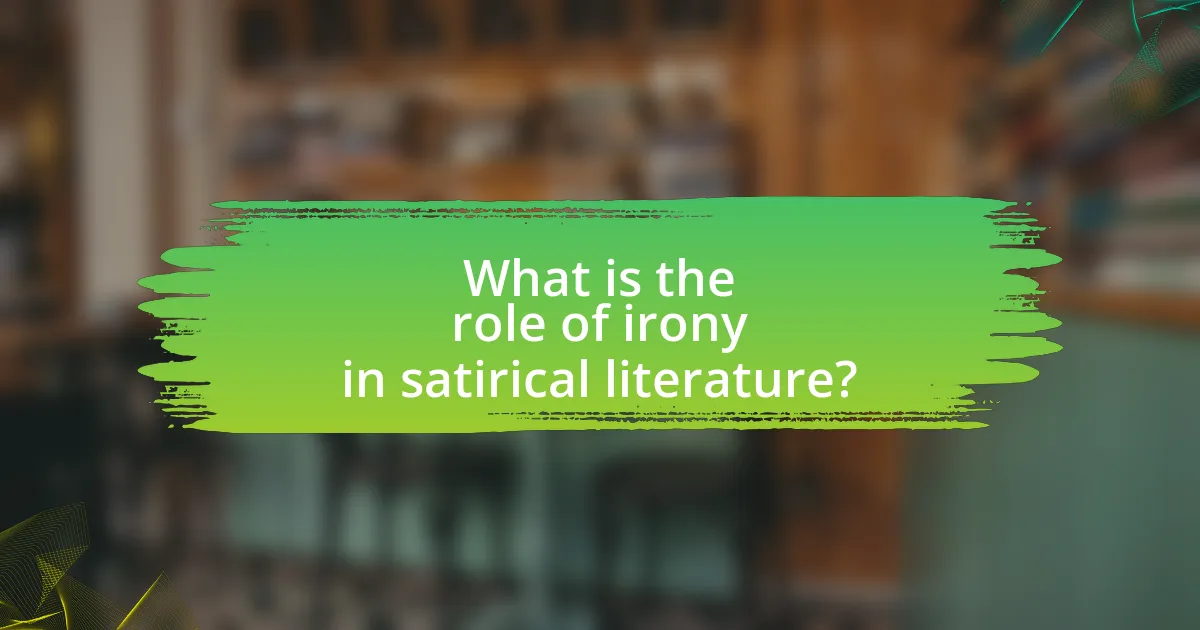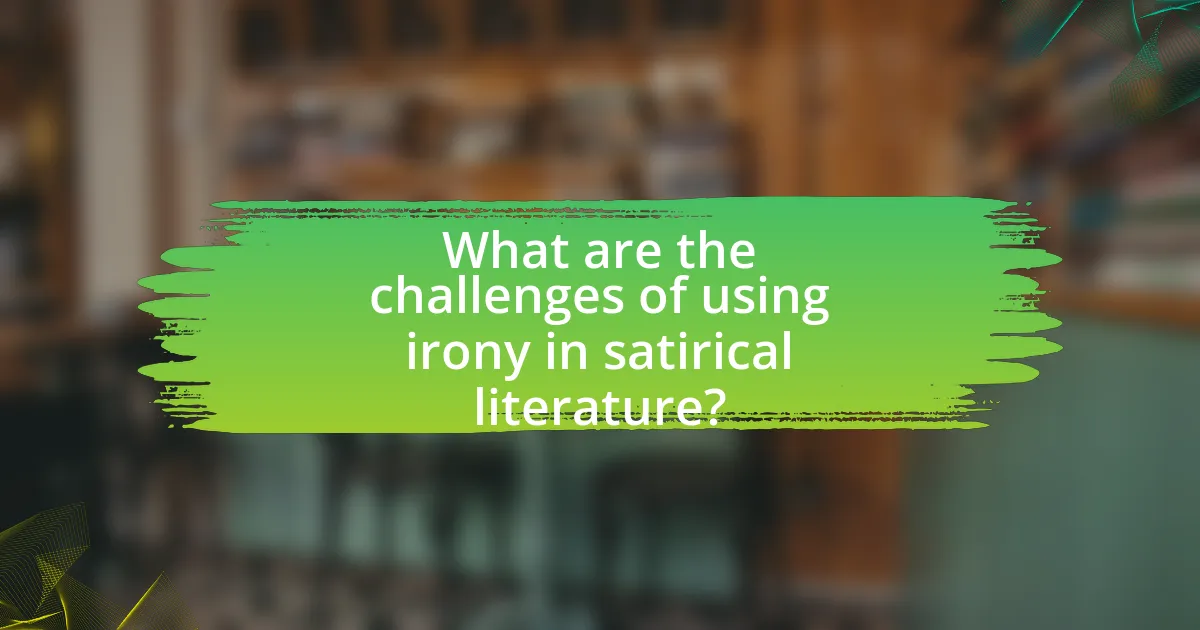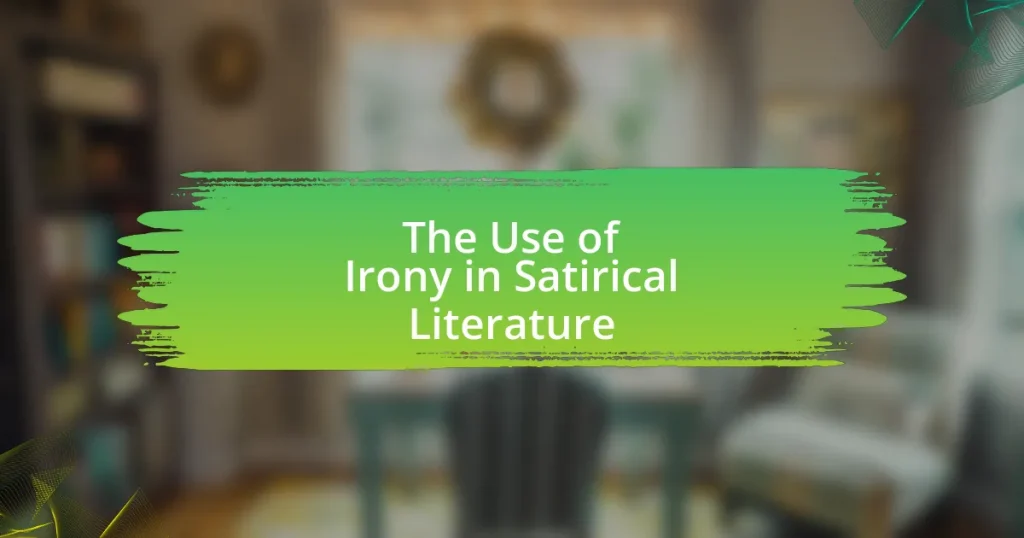The article examines the role of irony in satirical literature, highlighting its significance as a device that exposes societal flaws and absurdities by contrasting reality with expectation. It discusses various types of irony, including verbal, situational, and dramatic irony, and their effectiveness in enhancing satire. The article also explores the evolution of irony from classical to contemporary works, illustrating how authors utilize this technique to provoke critical thought and engage readers. Additionally, it addresses the challenges of using irony, such as potential misinterpretation and the risks of overuse, while offering strategies for balancing irony with clarity to effectively convey satirical messages.

What is the role of irony in satirical literature?
Irony serves as a critical device in satirical literature by highlighting the disparity between reality and expectation, often to expose societal flaws or absurdities. This literary technique allows authors to convey criticism in a manner that is both engaging and thought-provoking, prompting readers to reflect on the contradictions present in social norms, politics, and human behavior. For instance, Jonathan Swift’s “A Modest Proposal” employs irony to critique British policy towards the Irish, using exaggerated suggestions to underscore the inhumanity of the situation. Such use of irony not only entertains but also encourages deeper contemplation of serious issues, making it an essential element in the effectiveness of satire.
How does irony enhance the effectiveness of satire?
Irony enhances the effectiveness of satire by creating a contrast between appearance and reality, which allows the audience to recognize the absurdities of the subject being critiqued. This contrast often highlights the flaws or contradictions in societal norms, behaviors, or policies, making the satirical message more impactful. For example, in Jonathan Swift’s “A Modest Proposal,” the ironic suggestion of solving poverty by selling children as food underscores the inhumanity of the British government’s neglect of the Irish populace. This use of irony not only provokes thought but also elicits a strong emotional response, reinforcing the satirical critique.
What are the different types of irony used in satire?
The different types of irony used in satire include verbal irony, situational irony, and dramatic irony. Verbal irony occurs when a speaker says one thing but means another, often for humorous or emphatic effect, as seen in works like Jonathan Swift’s “A Modest Proposal.” Situational irony involves a discrepancy between what is expected to happen and what actually occurs, exemplified in George Orwell’s “Animal Farm,” where the outcome contradicts the initial intentions of the characters. Dramatic irony arises when the audience knows more about a situation than the characters do, creating tension and humor, as illustrated in many of Shakespeare’s plays. These forms of irony serve to critique societal norms and highlight contradictions within human behavior.
How does situational irony differ from verbal irony in satire?
Situational irony differs from verbal irony in satire primarily in the nature of the discrepancy it highlights. Situational irony occurs when there is a stark contrast between what is expected to happen and what actually occurs, often leading to an unexpected outcome that can be humorous or poignant. For example, in a satirical context, a fire station burning down exemplifies situational irony, as it subverts the expectation that a place dedicated to preventing fires would be safe from them.
In contrast, verbal irony involves a speaker saying one thing but meaning another, often for humorous or emphatic effect. This can be seen in satirical remarks where a character might say, “What a beautiful day!” during a storm, highlighting the discrepancy between the literal statement and the actual situation.
Both forms of irony serve to critique or expose flaws in society, but they do so through different mechanisms: situational irony through unexpected outcomes and verbal irony through contradictory statements.
Why is irony a crucial element in satirical works?
Irony is a crucial element in satirical works because it allows authors to convey criticism of societal norms and behaviors in a way that is both engaging and thought-provoking. By employing irony, satirists can highlight the discrepancies between reality and expectations, often exposing hypocrisy or absurdity in a manner that encourages reflection. For instance, Jonathan Swift’s “A Modest Proposal” uses ironic suggestions to critique British policy towards the Irish, effectively illustrating the dire situation through exaggerated and absurd recommendations. This technique not only entertains but also provokes critical thought, making irony an essential tool in the satirical genre.
How does irony contribute to the critique of societal norms?
Irony serves as a powerful tool in critiquing societal norms by highlighting the discrepancies between reality and expectations. Through the use of irony, authors can expose the absurdities and contradictions inherent in social conventions, prompting readers to question accepted beliefs. For instance, in Jonathan Swift’s “A Modest Proposal,” the ironic suggestion of solving poverty through cannibalism starkly critiques the indifference of society towards the plight of the poor. This juxtaposition of a shocking proposal against a serious social issue forces readers to confront the moral failings of their own society. Thus, irony not only entertains but also encourages critical reflection on societal values and behaviors.
What impact does irony have on reader perception?
Irony significantly influences reader perception by creating a contrast between expectation and reality, which can evoke critical thinking and emotional responses. This literary device prompts readers to question the surface meaning of the text, leading to deeper interpretations and engagement with the underlying themes. For instance, in satirical literature, irony often highlights societal flaws, encouraging readers to reflect on real-world issues. Research indicates that irony can enhance cognitive engagement, as readers must reconcile the discrepancy between the literal and intended meanings, thereby fostering a more active reading experience.

How has the use of irony evolved in satirical literature?
The use of irony in satirical literature has evolved from straightforward mockery to a more nuanced and complex form of critique. Initially, satirical works, such as those by Jonathan Swift in “A Modest Proposal,” employed irony primarily to expose societal flaws through direct ridicule. Over time, the evolution of irony has incorporated layers of ambiguity and self-reflexivity, as seen in contemporary works like those of David Foster Wallace, where irony serves to highlight the absurdities of modern life while also questioning the effectiveness of irony itself. This shift reflects a broader cultural change, where irony is not just a tool for critique but also a means of exploring deeper existential themes, making it a more sophisticated instrument in the satirical arsenal.
What historical examples illustrate the evolution of irony in satire?
Historical examples illustrating the evolution of irony in satire include the works of Aristophanes in ancient Greece, Jonathan Swift in the 18th century, and George Orwell in the 20th century. Aristophanes employed irony to critique Athenian society and politics, as seen in his play “Lysistrata,” where the absurdity of war is highlighted through the ironic actions of women withholding sex to end conflict. Jonathan Swift’s “A Modest Proposal” uses situational irony to expose the dire conditions of the Irish poor by suggesting that they sell their children as food, thereby shocking readers into recognizing the severity of social issues. George Orwell’s “Animal Farm” employs irony to illustrate the betrayal of revolutionary ideals, where the pigs, representing the ruling class, manipulate language and truth to maintain power, culminating in the ironic twist that “all animals are equal, but some animals are more equal than others.” These examples demonstrate how irony has been a powerful tool in satire to provoke thought and critique societal norms throughout history.
How did classical satirists employ irony in their works?
Classical satirists employed irony as a critical tool to expose societal flaws and human vices. For instance, in works like Juvenal’s “Satires,” irony is used to highlight the hypocrisy of Roman society, where the apparent praise of virtues often masks underlying corruption. Similarly, Horace’s “Satires” employs irony to create a contrast between the ideal and the real, allowing readers to discern the absurdities of human behavior. This technique not only engages the audience but also encourages reflection on moral and ethical issues, reinforcing the satirists’ critiques of their contemporary world.
What modern examples showcase the evolution of irony in contemporary satire?
Modern examples showcasing the evolution of irony in contemporary satire include television shows like “The Daily Show” and “Saturday Night Live,” which utilize irony to critique political figures and societal issues. “The Daily Show,” particularly under Jon Stewart and Trevor Noah, employs irony by juxtaposing serious news with absurd commentary, highlighting the discrepancies in political discourse. Similarly, “Saturday Night Live” uses irony in its sketches to mock public figures, often exaggerating their traits to reveal underlying truths about their actions and policies. These examples illustrate how contemporary satire has adapted irony to engage audiences and provoke critical thought about current events.
Why do authors choose irony as a tool in their satirical narratives?
Authors choose irony as a tool in their satirical narratives to highlight contradictions and provoke critical thinking. Irony allows writers to convey complex truths about societal norms, politics, and human behavior by presenting situations that are contrary to expectations. For example, in Jonathan Swift’s “A Modest Proposal,” the use of ironic suggestions critiques British policy towards the Irish, forcing readers to confront the absurdity of the situation. This technique effectively engages the audience, encouraging them to reflect on the underlying issues being satirized.
What are the advantages of using irony over other literary devices?
Irony offers distinct advantages over other literary devices, primarily by enhancing the depth of meaning and engaging the audience more effectively. It allows authors to convey complex ideas and critiques subtly, often leading to a more profound emotional response from readers. For instance, irony can highlight contradictions in societal norms or human behavior, making it a powerful tool in satirical literature. This is evidenced by works like Jonathan Swift’s “A Modest Proposal,” where irony underscores the absurdity of the proposed solution to poverty, prompting readers to reflect critically on the real issues at hand. Thus, irony not only entertains but also provokes thought, making it a unique and impactful literary device.
How does irony engage readers differently than straightforward criticism?
Irony engages readers differently than straightforward criticism by prompting them to recognize contradictions and deeper meanings, which fosters active interpretation. While straightforward criticism presents a clear stance, irony requires readers to engage cognitively, as they must discern the underlying message that contrasts with the literal expression. This engagement is evident in satirical literature, where authors like Jonathan Swift employ irony to critique societal norms, compelling readers to reflect on the absurdities of those norms rather than simply accepting a direct critique. The effectiveness of irony lies in its ability to provoke thought and discussion, making readers more active participants in the narrative.

What are the challenges of using irony in satirical literature?
The challenges of using irony in satirical literature include the risk of misinterpretation by the audience, which can lead to confusion about the author’s intent. Irony relies heavily on context and cultural understanding; if readers lack the necessary background, they may not grasp the satirical message. Additionally, the effectiveness of irony can be diminished if the audience perceives it as too subtle or overly complex, resulting in a failure to engage with the satire. Historical examples, such as Jonathan Swift’s “A Modest Proposal,” illustrate that while irony can provoke thought, it can also elicit backlash if the audience misreads the satirical tone, leading to unintended consequences.
How can irony be misinterpreted by readers?
Irony can be misinterpreted by readers when they fail to recognize the intended contrast between literal meaning and the actual message. This misinterpretation often occurs due to cultural differences, lack of context, or unfamiliarity with the author’s style. For instance, in Jonathan Swift’s “A Modest Proposal,” readers who take the text at face value may miss the satirical critique of British policy towards the Irish, leading to a misunderstanding of the work’s true purpose. Such misinterpretations highlight the importance of context and the reader’s background in understanding irony effectively.
What factors contribute to the misunderstanding of irony in satire?
Misunderstanding of irony in satire primarily arises from differences in cultural context, audience familiarity with the subject matter, and the complexity of the satirical message. Cultural context plays a significant role, as irony often relies on shared knowledge or societal norms that may not be universally understood. For instance, a satirical piece referencing specific political events may confuse audiences unfamiliar with those events. Additionally, audience familiarity with satire itself can influence comprehension; individuals who lack experience with satirical forms may misinterpret the intended irony. The complexity of the satirical message also contributes, as layered meanings can lead to confusion if the audience does not grasp the underlying critique. These factors collectively hinder the effective communication of irony in satirical literature.
How can cultural context affect the reception of ironic satire?
Cultural context significantly affects the reception of ironic satire by shaping the audience’s understanding and interpretation of the humor. Different cultures possess unique values, beliefs, and social norms that influence how irony is perceived; for instance, what is considered humorous in one culture may be offensive or confusing in another. Research indicates that irony relies on shared knowledge and social cues, which vary across cultures, leading to potential misinterpretations. A study by K. A. K. K. (2015) in “Journal of Cross-Cultural Psychology” highlights that individuals from collectivist cultures may interpret irony differently than those from individualist cultures, affecting their appreciation of satirical content. Thus, cultural context is crucial in determining whether ironic satire is understood and appreciated or dismissed and misunderstood.
What are the risks of overusing irony in satirical writing?
Overusing irony in satirical writing can lead to misinterpretation and disengagement from the audience. When irony is excessively employed, readers may struggle to discern the author’s true intent, resulting in confusion about the message being conveyed. This confusion can dilute the impact of the satire, as the audience may not grasp the underlying critique or humor. Additionally, excessive irony can create a sense of detachment, making it difficult for readers to connect emotionally with the content. Research indicates that effective satire relies on a balance of irony and clarity; for instance, studies show that clear messaging enhances audience engagement and comprehension. Therefore, while irony is a powerful tool in satire, its overuse poses significant risks to effective communication and audience connection.
How can excessive irony dilute the intended message of satire?
Excessive irony can dilute the intended message of satire by creating ambiguity that obscures the satirical intent. When irony is overused, it can lead to confusion among the audience, making it difficult for them to discern the underlying critique or commentary. For instance, in Jonathan Swift’s “A Modest Proposal,” the irony is sharp and focused, effectively highlighting the absurdity of British policy towards the Irish. However, if Swift had employed excessive irony, the audience might have misinterpreted his message, failing to recognize the serious social issues he aimed to address. This demonstrates that a balanced use of irony is crucial for maintaining clarity in satire.
What strategies can authors use to balance irony and clarity?
Authors can balance irony and clarity by employing straightforward language while embedding ironic elements within contextually rich scenarios. This approach allows readers to grasp the underlying message without confusion. For instance, using clear character motivations and relatable situations can enhance understanding, while irony can be introduced through dialogue or situational contrasts. Research indicates that effective use of irony often relies on the audience’s ability to recognize incongruities, which can be facilitated by maintaining a coherent narrative structure. By ensuring that the ironic elements serve the overall clarity of the message, authors can create a more impactful satirical work.
What best practices should writers follow when incorporating irony in satire?
Writers should ensure clarity and consistency when incorporating irony in satire. This involves establishing a clear contrast between the literal meaning and the intended message, allowing the audience to recognize the irony without confusion. For instance, using exaggerated scenarios or characters can highlight the absurdity of real-life situations, making the satirical point more impactful. Additionally, maintaining a tone that aligns with the subject matter helps reinforce the irony; for example, a serious tone can enhance the comedic effect of absurd statements. Effective use of irony also requires an understanding of the audience’s perspective, as what is ironic to one group may not be to another. This approach is supported by the fact that successful satirical works, such as Jonathan Swift’s “A Modest Proposal,” effectively utilized irony to provoke thought and critique societal issues.
How can writers effectively convey their message through irony?
Writers can effectively convey their message through irony by using contrasting statements or situations that highlight the difference between appearance and reality. This technique allows writers to critique societal norms or behaviors by presenting them in a way that reveals their absurdity. For example, in George Orwell’s “Animal Farm,” the ironic twist of the pigs becoming indistinguishable from the oppressive humans they initially overthrew underscores the theme of power corruption. Such irony not only engages readers but also prompts them to reflect critically on the underlying message, making it a powerful tool in satirical literature.
What techniques can enhance the impact of irony in satirical literature?
Techniques that can enhance the impact of irony in satirical literature include exaggeration, juxtaposition, and the use of unreliable narrators. Exaggeration amplifies the absurdity of a situation, making the ironic elements more pronounced; for example, in Jonathan Swift’s “A Modest Proposal,” the extreme suggestion of eating children highlights societal indifference. Juxtaposition places contrasting ideas or characters side by side, creating a stark contrast that emphasizes irony, as seen in George Orwell’s “Animal Farm,” where the pigs’ rise to power subverts the original revolutionary ideals. The use of unreliable narrators can also deepen irony by presenting a skewed perspective that misleads the reader, as demonstrated in Mark Twain’s “The Adventures of Huckleberry Finn,” where Huck’s naïve viewpoint reveals deeper societal flaws. These techniques collectively strengthen the ironic commentary inherent in satirical works.






